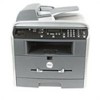Dell 1600n Multifunction Mono Laser Printer Dell Laser Multi-Function Printer - Page 170
Facsimile Specifications, Paper Specifications, Overview
 |
View all Dell 1600n Multifunction Mono Laser Printer manuals
Add to My Manuals
Save this manual to your list of manuals |
Page 170 highlights
Facsimile Specifications Item Compatibility Applicable line Data coding Modem speed Transmission speed Description ITU-T Group 3 Public Switched Telephone Network (PSTN) or behind PABX MH/MR/MMR (ECM Mode) and JPEG for color fax transmission 33.6 Kbps Approx. 3 seconds/page Scanning speed * Transmission time applies to memory transmission of text data with ECM compression using only ITU-T No.1 Chart. Document glass: approx. 3 seconds/A4 (at standard fax resolution mode) Maximum document length Paper size Resolution ADF: approx. 5 seconds/Letter (at standard fax resolution mode), 7.5 seconds/Letter (at fine fax resolution mode) Document glass: 297 mm ADF: 356 mm Letter, A4, Legal Standard: 203 x 98 dpi Fine: 203 x 196 dpi User Memory Halftone Super Fine: 300 x 300 dpi 4 MB (320 pages) 256 levels Paper Specifications Overview Your multi-function printer accepts a variety of print materials, such as cut-sheet paper (including up to 100 percent recycled fiber content paper), envelopes, labels, transparencies and custom-size paper. Properties, such as weight, composition, grain and moisture content, are important factors affecting the multi-function printer's performance and the output quality. Paper that does not meet the guidelines outlined in this User's Guide can cause the following problems: Poor print quality Increased paper jams















